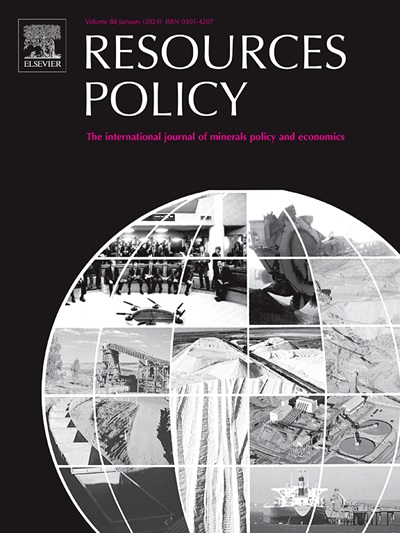Minerals’ criticality and countries' mining competitiveness: Two faces of the same coin
IF 10.2
2区 经济学
0 ENVIRONMENTAL STUDIES
引用次数: 0
Abstract
This article introduces a novel theoretical and empirical framework for estimating the criticality of key minerals that are intensively used in the energy transition and the mining competitiveness of countries producing them, using economic complexity techniques.
The theoretical framework proposes that the most competitive countries are those exporting a broad range of mineral goods, including the most critical ones. Meanwhile, the most critical minerals are the least ubiquitous and are exported by the most competitive countries. The empirical framework relies on an endogenous system of equations in which countries’ mining competitiveness and mineral criticality are simultaneously co-determined. The equation system is solved using the Fitness-Criticality algorithm (FCa), an adaptation of the Economic Fitness-Complexity algorithm.
The results show that South Africa, Russia, the United States, and China are the most competitive mining countries. Meanwhile, the platinum group metals, silicon, rare earths, and lithium are the most critical minerals. These results are consistent with other methodologies employed by different experts that separately estimate both dimensions and derive rankings of countries and minerals, but are obtained with a methodology that offers substantial advantages.
矿产的关键性与国家的矿业竞争力:一枚硬币的两面
本文介绍了一个新颖的理论和实证框架,利用经济复杂性技术估算能源转型中大量使用的关键矿产的关键性以及生产这些矿产的国家的矿业竞争力。该理论框架提出,最具竞争力的国家是那些出口包括最关键矿产在内的各种矿产品的国家。同时,最关键的矿产品最不普遍,也由最具竞争力的国家出口。实证框架依赖于一个内生方程组,在这个方程组中,各国的矿业竞争力和矿产临界度是同时共同决定的。该方程系统使用 "适度临界 "算法(FCa)求解,该算法是对 "经济适度复杂性 "算法的改编。同时,铂族金属、硅、稀土和锂是最关键的矿产。这些结果与不同专家采用的其他方法一致,即分别估算两个维度并得出国家和矿产的排名,但采用的方法具有很大优势。
本文章由计算机程序翻译,如有差异,请以英文原文为准。
求助全文
约1分钟内获得全文
求助全文
来源期刊

Resources Policy
ENVIRONMENTAL STUDIES-
CiteScore
13.40
自引率
23.50%
发文量
602
审稿时长
69 days
期刊介绍:
Resources Policy is an international journal focused on the economics and policy aspects of mineral and fossil fuel extraction, production, and utilization. It targets individuals in academia, government, and industry. The journal seeks original research submissions analyzing public policy, economics, social science, geography, and finance in the fields of mining, non-fuel minerals, energy minerals, fossil fuels, and metals. Mineral economics topics covered include mineral market analysis, price analysis, project evaluation, mining and sustainable development, mineral resource rents, resource curse, mineral wealth and corruption, mineral taxation and regulation, strategic minerals and their supply, and the impact of mineral development on local communities and indigenous populations. The journal specifically excludes papers with agriculture, forestry, or fisheries as their primary focus.
 求助内容:
求助内容: 应助结果提醒方式:
应助结果提醒方式:


